Do you have contingency on your project?
In Eliyahu Goldratt’s bookCritical Chainhe calls it safety, but whatever name for it you use, most projects have an element of budget provision put aside in case of emergency.
Your new project was approved for funding. That in itself is a huge step. But before you start the celebration, there are some details to check first. What exactly got approved? What are the budget constraints that come with it? Is it enough? Does the funding include contingency?
If you’re wondering what budget contingency is, then you have come to the right place. This article will explain project contingency, how to calculate contingency and how to manage it within the scope of your projects.
What is Project Contingency?
It is not practical to document the infinite number of things that could go ‘wrong’ on a project.
You will never know when Murphy’s law will get kicked in on your project: “Murphy’s Law is the adage that “anything that can go wrong will go wrong”.”
That’s where project contingency comes in. Think of it as the promise of additional resources (typically time and/or money) allocated in a project to address possible risks and uncertainty.
Project contingency is the additional resources put aside to address potential risk and uncertainty in a project.
There are two types of contingencies typically used on projects:
- Budget Contingency: Additional amount of funds added to the base cost estimate of a project to cover estimation uncertainties and risks
- Schedule Contingency: Additional time allocated within a project schedule to account for uncertainties and risks that may impact the project’s timeline.
The contingency amount varies based on the project’s size, type, risks involved, and the level of estimating effort. It can range from less than 5% for low-risk projects to over 20% for high-risk projects. The amount of each of these will be documented in a project contingency plan.
Why is Contingency Important?
Contingency is crucial in project management as it provides a safety net for dealing with uncertainties and risks that may arise during the project lifecycle. It ensures that projects can be completed successfully despite unforeseen challenges.
The amount of contingency used in a project is based on risk exposure and estimate uncertainty facing a project.
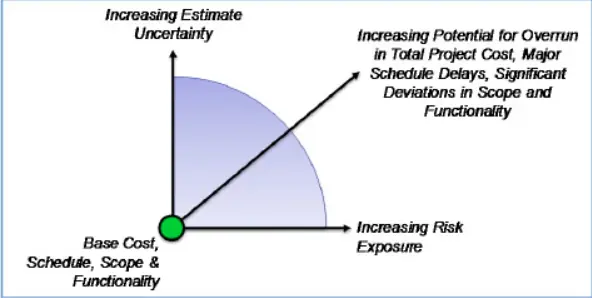
Contingency is important for:
- Covering a uncertainty and risk exposure in projects
- Providing more realisitc business cases and cash flow
- Guarding a project from potentially harmful trade offs in schedule, scope and functionality
- Improving transparency and building trust in schedule and cost estimations
How to Calculate Contingency?
The basic process of calculating contingency is:
- After you come up with the budget estimation, calculate estimate uncertainty
- Determine level of risk/uncertainty in a project
- Based on level of risk involved, work out how much money to put aside within the overall project costs, to cover this risk exposure
- Ringface that amount until it is needed
As shown in the figure, the total estimated project cost at completion includes the base cost estimate and contingency.
The base cost estimate is expected cost of known scope and contingency the amount of funds set aside to cover risk exposure and estimate uncertainty.
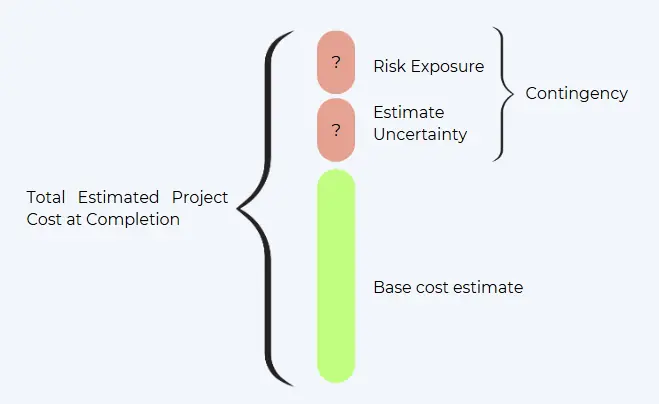
Contingency Management Process
Let’s closely look at contingency management process:
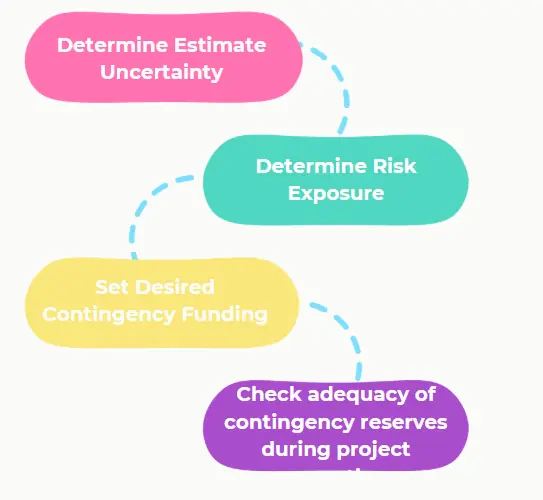
Step 1: Determine Estimate Uncertainty.
Estimate uncertainty refers to the degree of confidence in the accuracy of the project estimates. Estimate uncertainty is used:
- To cover uncertainties that are inherent in the estimating process
- Minor errors and omission that occur when the estimate is put together.
Please note, Estimate Contingency is not intended to cover major changes in scope
How to determine estimate uncertainty?
There are several different ways by which you can decide estimate uncertainty.
- Historical Data: Use historical data from previous projects to compare and validate the current estimates. This includes labor, materials, and equipment costs.
- Vendor Quotes: Incorporate quotes from vendors for materials and services. These quotes provide a more accurate basis for the estimates.
- Use of advance statistical techniques such as Monte-Carlo analysis: Monte-Carlo analysis software calculates a cumulative probability of achieving the project at or below the budgeted cost The level of confidence given by Monte Carlo Analysis can be used to estimate uncertainty
As per the Association for Advancement of Cost Engineers (AACE), there are five classes of estimates.
The most accurate estimate being a class 1 estimate and least accurate a class 5 estimate.
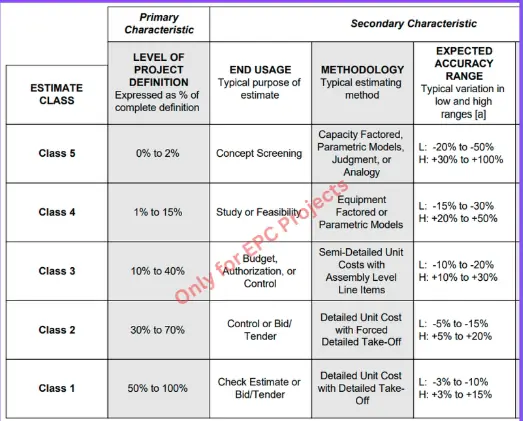
Based on historical data of similar projects, you can determine estimate class and add contingency percentage.
For e.g. for $10 million system up-gradation project, if project team is convinced on “class 3 estimate” (based on historical data), the base cost estimate will range from $9 million to $12 million
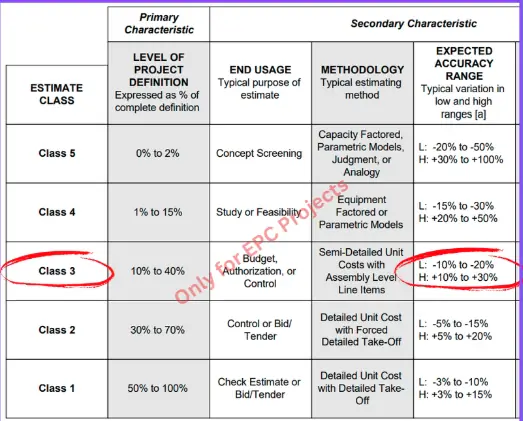
Step 2 – Determine Risk Exposure
The risk exposure is determined by:
- Creating initial risk register
- Quantifying risk under Expected Monetary Value (EMV)
The process of managing risks is continuous one, and robust risk management requires:
- Good risk statement provided in IF event, THEN consequence format. For e.g. IF the Factory Acceptance Test fails during stage inspection due to unresolved technical defects, THEN the project will incur a 3-week delay to address rework and retesting.
- Quantify the risk impact in terms of cost or schedule impact
- Determine of probability of occurrence of each risk event
- Calculation of EMV for each risk (probability * impact)
- Summation of risk EMVs (simple approach to aggregation of risk)
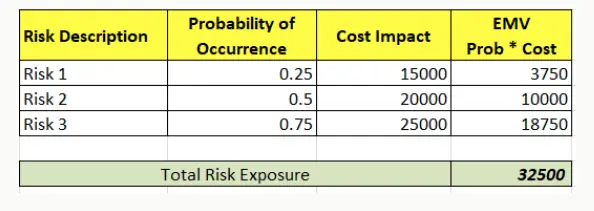
Set Desired Contingency Funding
Total Contingency Request for $10 million system up-gradation project.
If project team is convinced on “class 3 estimate” (based on historical data), the base cost estimate will range from $9 million to $12 million. We will assume 10% of $10 million as Total estimate contingency, which is $1 million
We have calculated total Risk contingency as $32,500, converted into $0.032 million.
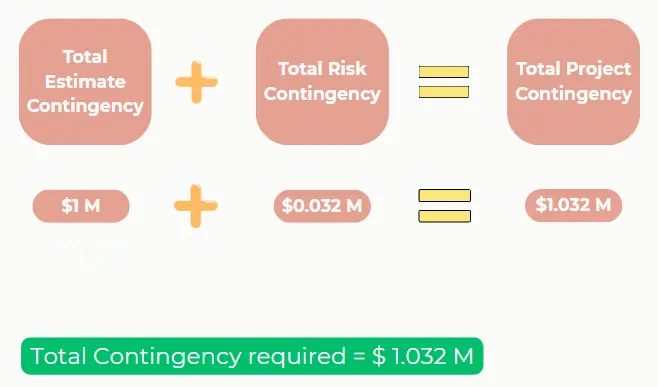
Check Adequacy of Contingency
How to monitor a contingency funds during project progress?
Too much contingency leads to sub-optimal allocation of project funds
Too little contingency can result in the need to go back to sponsor for money
Two metrics are used to track the contingency reserve:
- Contingency to Estimate-to-complete (ETC)
- Contingency to Risk Exposure (EMV)
Contingency to estimate–to-complete (ETC)
- Formula: (Contingency remaining in $) / (ETC excluding contingency)
- Rule of thumb: greater than 3% and less than 15% is reasonable
Contingency to risk exposure (EMV)
- Formula: [Contingency remaining in $] / (EMV)
- Rule of thumb: Generally between +/- 25% is reasonable (0.75 to 1.25)
Your status report should flag the contingency adequacy when either of a metric exceed the rule of thumb boundaries mentioned previously
How to Access Contingency Funds?
A good practice is to devise a process that will provide traceability of contingency funds. There must be a formal process for requesting and allocating contingency funds
That traceability is important to ensure transparency, in the event of a project audit, for potential stakeholder questions, etc.
Summary
Project contingency is a critical component in project management that ensures a realistic and transparent approach to handling uncertainties and risks. By incorporating contingency into the project budget, project managers can avoid harmful trade-offs in schedule, scope, and functionality, ultimately leading to better project outcomes.
References
Do you want to Master the World’s Most Popular Project Management Tool?
Check out my 18 Hours LIVE Online Course on Microsoft Projects
or additional information:
Visit the course web-page:pmfornonpm.in/new-courses/
Email:pmfornonpm@gmail.com




